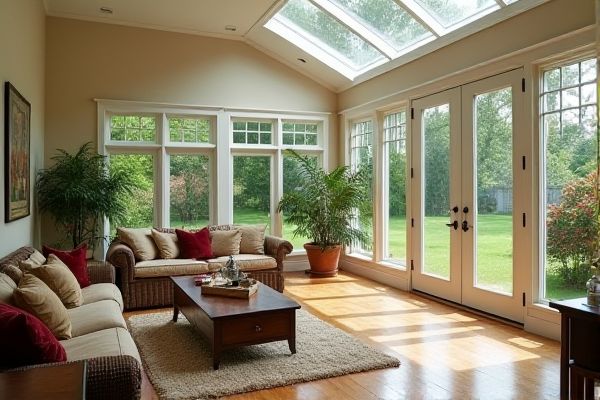
Clerestory windows offer high placement to maximize natural light while maintaining privacy, whereas floor-to-ceiling windows provide expansive views and a strong indoor-outdoor connection, ideal for sunrooms designed to feel open and airy. Discover which window style best suits Your sunroom's design and functionality by exploring the rest of this article.
Table of Comparison
| Feature | Clerestory Windows Sunroom | Floor-to-Ceiling Windows Sunroom |
|---|---|---|
| Lighting | High natural light with controlled glare | Maximum natural light and panoramic views |
| Privacy | High privacy due to elevated window placement | Lower privacy; windows at eye level |
| Ventilation | Good ventilation if windows open | Excellent ventilation with operable full-height windows |
| Energy Efficiency | Better insulation, less heat loss | Potential heat gain/loss; requires double glazing |
| View | High-level outside views, limited direct sightlines | Unobstructed ground-level views |
| Installation Complexity | Moderate complexity, fits standard walls | Higher complexity and cost due to size |
| Design Style | Modern, architectural emphasis on height | Contemporary, open and airy feel |
| Use Case | Ideal for light control and privacy-focused sunrooms | Best for scenic views and bright living spaces |
Introduction to Sunroom Window Options
Clerestory windows and floor-to-ceiling windows offer distinct benefits for sunrooms, impacting natural light and ventilation. Clerestory windows, positioned high on walls, maximize daylight while preserving privacy and wall space for furniture or decor. Floor-to-ceiling windows provide expansive outdoor views and abundant sunlight, creating a seamless connection between indoor and outdoor spaces.
What Are Clerestory Windows?
Clerestory windows are high, vertically positioned windows located near the roofline that allow ample natural light to enter while maintaining privacy and wall space. Unlike floor-to-ceiling windows, clerestory windows do not compromise your furnishing layout or expose your entire sunroom to direct views from outside. These windows enhance daylighting and ventilation efficiently, making them ideal for sunrooms that require a balance between light, privacy, and interior design flexibility.
What Are Floor-to-Ceiling Windows?
Floor-to-ceiling windows are expansive glass panels that extend from the floor directly to the ceiling, maximizing natural light and providing uninterrupted outdoor views in sunrooms. These windows enhance the sense of openness and connect interior spaces with the surrounding environment, often used to create a modern, airy atmosphere. Their design contrasts with clerestory windows, which are smaller, high-placed openings that primarily bring in daylight while preserving privacy and wall space.
Natural Light and Illumination Comparison
Clerestory windows offer controlled natural light by placing high, narrow panes that diffuse sunlight evenly, reducing glare and overheating. Floor-to-ceiling windows maximize illumination by allowing expansive, unobstructed views and abundant sunlight, creating a bright, open atmosphere for your sunroom. Your choice depends on balancing direct sunlight exposure with the desired level of brightness and energy efficiency.
Energy Efficiency and Insulation
Clerestory windows offer superior energy efficiency and insulation in a sunroom by allowing natural light to enter while maintaining wall space for better insulation. Their elevated position reduces heat loss and minimizes direct solar gain, helping keep your sunroom cooler in summer and warmer in winter. Floor-to-ceiling windows provide expansive views but often result in greater heat transfer, requiring advanced glazing or additional treatments to enhance energy performance.
Privacy Considerations in Sunroom Design
Clerestory windows in sunroom design offer enhanced privacy by positioning natural light sources high on the walls, reducing the likelihood of direct visibility from neighbors or passersby. Floor-to-ceiling windows maximize sunlight and outdoor views but can compromise privacy unless supplemented with shading solutions, such as blinds or tinted glass. Choosing clerestory windows supports a balanced sunroom environment that prioritizes natural lighting while maintaining discretion in residential settings.
Aesthetic Impact on Sunroom Spaces
Clerestory windows create a subtle, elevated source of natural light that enhances the architectural depth and maintains privacy in your sunroom, while floor-to-ceiling windows offer expansive, uninterrupted views and maximize sunlight, fostering a seamless connection with the outdoors. The high placement of clerestory windows adds a unique, modern aesthetic that draws the eye upward and complements minimalist or contemporary designs. Floor-to-ceiling windows dramatically transform the sunroom into a bright, open space, emphasizing transparency and integrating exterior landscapes as part of the interior decor.
Ventilation and Airflow Differences
Clerestory windows enhance ventilation by allowing hot air to escape through high openings, promoting natural airflow without sacrificing privacy. Floor-to-ceiling windows provide expansive views but may limit ventilation options unless they include operable panes, potentially reducing fresh air circulation in your sunroom. Choosing clerestory windows can optimize airflow and temperature regulation, creating a more comfortable and energy-efficient space.
Cost and Installation Factors
Clerestory windows typically cost less to install than floor-to-ceiling windows due to their smaller size and simpler framing requirements, reducing both material and labor expenses. Installation of clerestory windows is generally quicker and less complex, as they can be integrated above existing walls without major structural changes, whereas floor-to-ceiling windows often require reinforced support and precise alignment to ensure stability and weatherproofing. Your choice should consider budget constraints and the impact of installation time on overall project costs.
Choosing the Best Window Style for Your Sunroom
Clerestory windows offer high placement that maximizes natural light while preserving privacy and wall space, ideal for sunrooms requiring controlled sunlight and ventilation. Floor-to-ceiling windows provide expansive views and immersive daylight, perfect for creating an open, airy feel but may require additional shading or insulation for energy efficiency. When choosing the best window style for your sunroom, consider your climate, privacy needs, and how much natural light you want to balance comfort and aesthetics.
 homyna.com
homyna.com